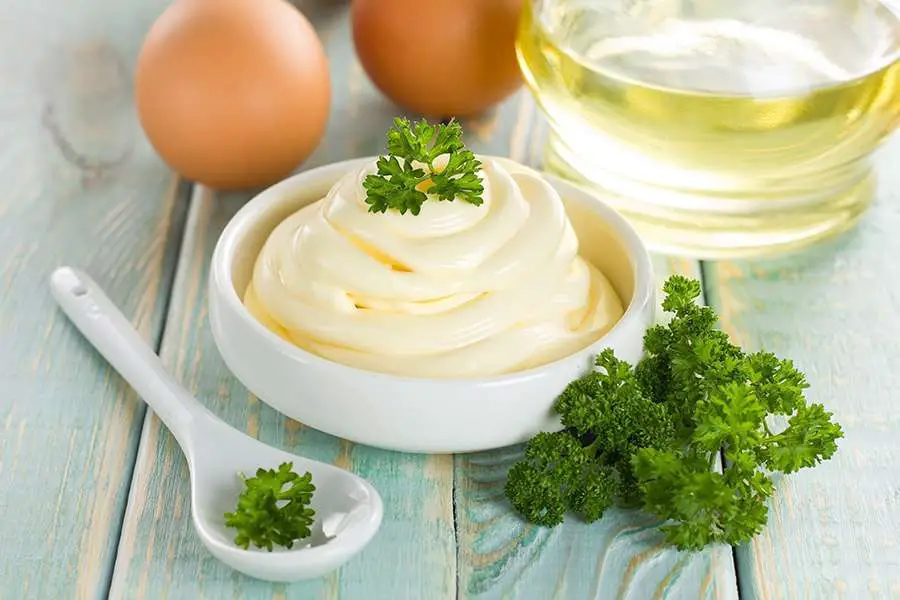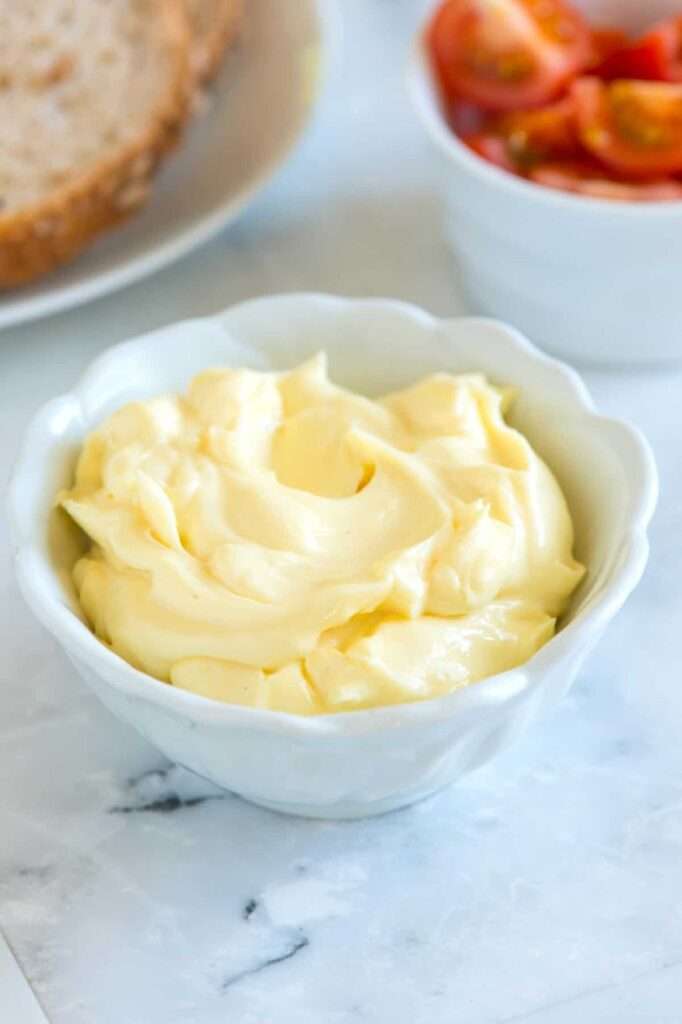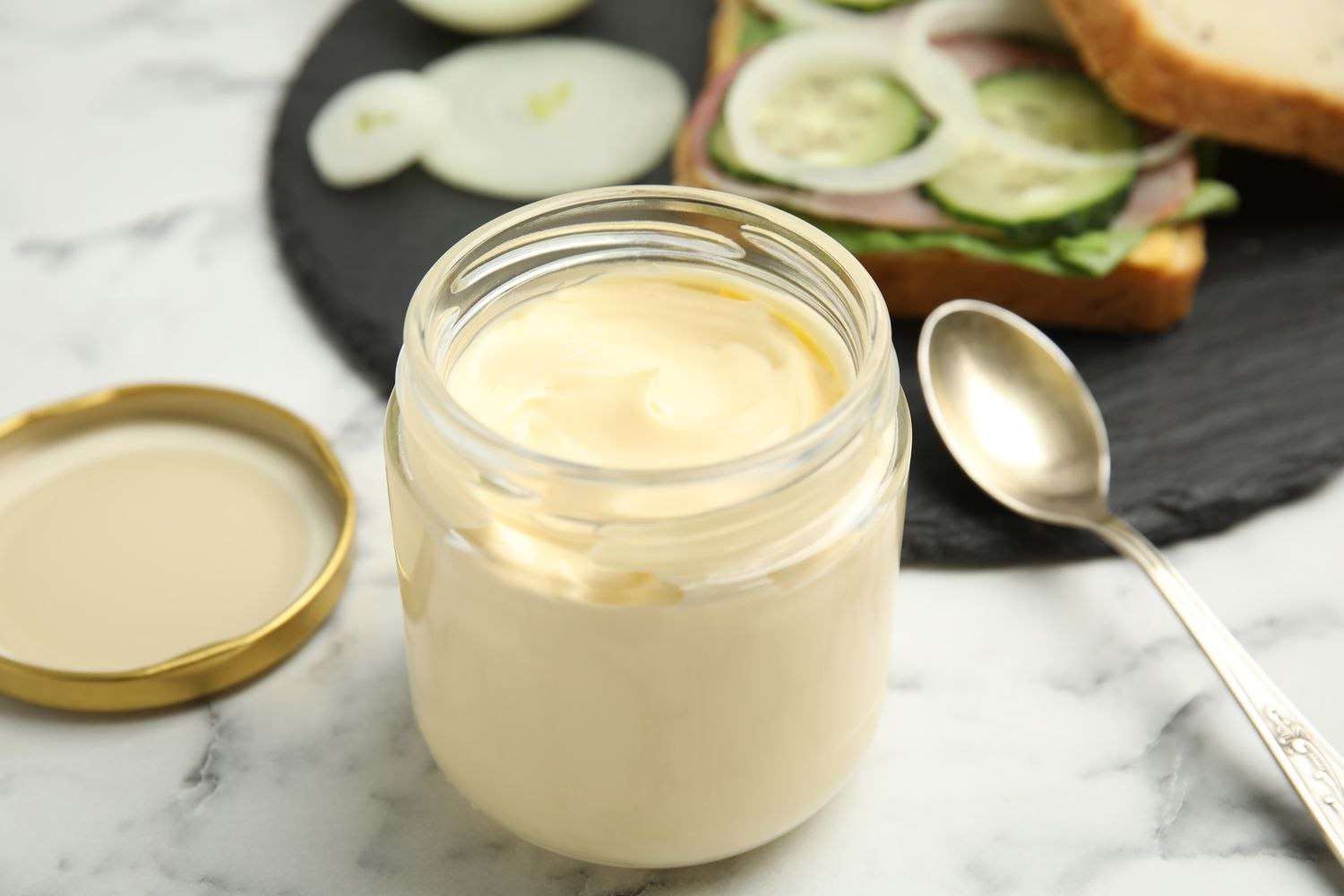How long does mayonnaise last?
Unopened mayonnaise lasts until the ‘best by’ date; once opened, it stays fresh for 2-3 months in the fridge. An opened jar of mayo should never sit out for more than two hours.
How long does mayonnaise last? Mayonnaise, a staple in many kitchens, is a creamy condiment often used to enhance flavors in dishes. Ensuring its freshness is crucial for both taste and health reasons. Store-bought mayonnaise, which is pasteurized, typically has a longer shelf life than homemade versions due to preservatives.
Consumers should always check the ‘best by’ date on store-bought mayonnaise to gauge its shelf life when unopened. For the best quality, after opening, keeping mayonnaise refrigerated is vital, as it is prone to spoilage at room temperature. To maintain the quality of mayonnaise, practice good hygiene by using clean utensils when scooping it out, and remember that the sensory indicators of color, smell, and texture can signal when mayonnaise is no longer suitable for consumption.
Storage Duration: How Long Mayo Lasts
Unopened mayonnaise can be shelf-stable for months, usually up to its expiration date. Once opened, refrigerated mayo typically remains fresh for 2-3 months.
Storing mayonnaise properly is key to extending its shelf life and maintaining its quality. But just how long can you expect your jar of mayo to last? The answer depends on several factors, including whether it’s store-bought or homemade, and if it’s been opened or not.
Unopened Commercial Mayonnaise
- Shelf life before opening: Most commercial mayonnaise will have a best-by date printed on the jar, which is usually a good indicator of how long it will remain at peak quality. Typically:
- Unopened and stored at room temperature, it can last up to 3-4 months beyond its expiration date if kept away from direct sunlight and heat sources.
- Temperature considerations: Keeping your unopened mayonnaise in a consistent environment is crucial.
- A pantry or cupboard that stays at a regular room temperature is ideal to ensure the longevity of the mayonnaise.
Opened Commercial Mayonnaise
The clock starts ticking once the seal of your mayo is broken. However, proper storage can still preserve its freshness for a good period:
- Fridge life after opening:
- When stored in the refrigerator at or below 40°F (4°C), an opened jar of commercial mayonnaise can last for up to two months.
- Signs of spoilage:
- Always check for any unusual odors, colors, or separation. If anything seems off, it’s best to err on the side of caution and toss it out.
Homemade Mayonnaise
Homemade mayonnaise is a delightful addition to many dishes but requires careful attention due to its fresh ingredients:
- Shorter shelf life: As it lacks the preservatives found in store-bought varieties, homemade mayo has a significantly shorter lifespan.
- Generally, expect it to stay fresh for about one week when refrigerated in an airtight container immediately after preparation.
- Ingredient freshness:
- The overall shelf life also depends on the freshness of the eggs and oil used to make the mayonnaise. Use the freshest ingredients for the best taste and longest storage potential.
Extending Mayonnaise’s Shelf Life
To maximize the duration your mayonnaise remains safe and enjoyable to eat, consider these storage tips:
- Consistent refrigeration:
- Ensure that the mayonnaise is returned to the fridge promptly after each use, limiting exposure to the warm temperatures that can accelerate spoilage.
- Airtight containers:
- For homemade mayonnaise, always use a clean, airtight container to limit the risk of contamination and oxidation.
Signs That Mayonnaise Has Gone Bad
Keep an eye out for any indicators of spoilage, and when in doubt, do not consume:
- Changes in texture: Mayo that’s spoiled may separate or become lumpy, deviating from its customary creamy consistency.
- If the mayonnaise seems to have a different texture than normal, it’s likely no longer safe to eat.
- Odor and color changes:
- Discoloration or a sour smell can signify that the mayonnaise is past its prime and should be discarded.
Remember, practicing food safety should always be a priority. Trust your instincts—if something seems off with your mayonnaise, it’s better to play it safe and dispose of it. Enjoying your favorite creamy condiment is only a delight when it’s fresh and free of any spoilage risks!
Refrigeration Tips: Keeping Mayo Fresh
Mayonnaise freshness hinges on proper storage, with an unopened jar lasting up to its expiration date. Once opened, refrigerating mayo ensures a safe consumption period of about two to three months for optimal taste and safety.
You’ve probably asked yourself: how long can I keep this jar of mayo? Well, the shelf-life of mayonnaise greatly depends on how it’s stored. Refrigeration is critical in extending its freshness, preventing spoilage, and maintaining that creamy consistency we all love.
Here’s what you need to do to keep your mayo at its best:
Temperature Matters: The Right Fridge Settings
Chilling your mayo is crucial, but it’s not just about putting it in the fridge. Temperature plays a vital role:
- Keep it cool: Set your fridge to maintain a steady temperature between 35°F to 40°F (1.6°C to 4.4°C). This range is ideal for preventing bacterial growth while keeping your mayo fresh.
- Avoid the door: The fridge door is the warmest part, with temperature fluctuations that can affect mayo’s quality. Store it on a shelf towards the back instead.
First In, First Out: Organize Your Condiments
Keep track of your mayo’s shelf life by practicing a simple rotation method:
- Label and date: When you open a new jar, add a label with the current date so you always know how long it’s been in use.
- Front-row access: Place the older containers in front, ensuring that they get used first to avoid waste.

Seal Tightly: Oxygen Is Not A Friend To Mayo
Once you’ve used your mayo, preserving its freshness becomes a matter of containment:
- Airtight is right: Always make sure the lid is screwed on tightly after each use. Exposure to air can accelerate spoilage and alter the mayo’s taste.
- No cross-contaminating: Use a clean utensil every time to scoop out mayo. This prevents introducing other food particles that can spoil the mayo.
Proper Container: Glass Or Plastic?
Choosing the right container is more than just a preference:
- Glass jars: These are excellent for keeping flavors in and contaminants out, and they don’t absorb odors.
- Plastic containers: If you go for plastic, ensure it’s a food-grade type that’s BPA-free for safety and freshness.
Remember, by following these refrigeration tips, you can ensure that your mayonnaise remains delicious and safe to eat for as long as possible. Keep an eye on the jar’s expiration date, and pay attention to any changes in texture, color, or smell—these are telltale signs that it’s time to bid your mayo goodbye.
Keep your fridge organized and your mayo well within sight, and you’ll be all set for making sandwiches, dressings, and more with the freshest mayo possible.
Expiration Signs: Recognizing Bad Mayo
Unopened mayonnaise can last beyond its printed date, typically up to 3-4 months if refrigerated. Detect spoiled mayo by noting a sour smell, off-color, or any signs of mold—your keys to recognizing it’s time to toss it.
Consumers often find themselves questioning the freshness of their mayonnaise, a common condiment in many households. Recognizing when mayonnaise has gone bad is crucial to prevent the risk of foodborne illnesses. Contrary to popular belief, mayonnaise can spoil even when refrigerated, especially if it has been exposed to cross-contamination or stored improperly.
Now let’s delve into the telltale signs that your mayonnaise has gone past its prime.
Visual Changes
Before using mayo, it’s wise to look for any noticeable changes in its appearance.
- Discoloration: Mayo that has acquired an off color, typically yellow or brownish, is not safe to consume.
- Separation of Ingredients: A clear sign of spoiled mayo is when the oil separates from the rest of the ingredients, indicating a breakdown in the emulsion process.
Texture And Consistency Adjustments
The tactile feel of mayonnaise can also indicate if it’s time to toss it.
- Thickness: Fresh mayo is creamy and thick. If it appears lumpy or curdled, the mayonnaise is no longer good.
- Wateriness: Quality mayonnaise should not have excess water pooling at the top. If it does, this is a symptom of spoilage.
Odor Alteration
Sniffing the mayo is another method to test its freshness.
A pungent or sour smell distinct from the normal mild aroma indicates bacterial growth and spoilage. Do not ignore an unusual odor—trust your nose and discard any mayo that smells off.
Taste Test
Although the last line of defense, a taste test can be a conclusive measure.
But be cautious—only a tiny amount should be tasted, as spoiled mayo might taste overly sour or unnatural. If the flavor seems compromised, it’s best to err on the side of caution and dispose of the mayonnaise.
Storage Duration
Understanding how long mayonnaise lasts is critical.
- Unopened: An unopened jar of store-bought mayo can last up to its expiration date if stored in a cool, dark place.
- Opened: Once opened, mayonnaise should be consumed within two months and always kept refrigerated.
In following these guidelines, one can ensure they’re only consuming mayonnaise that is fresh and safe, thereby keeping the benefits to their taste buds and health. Always keep in mind that trusting your senses can be the most reliable method when determining if mayonnaise, or any food product, has spoiled.
Room Temperature Risks: Avoiding Room-temp Mayo
Understanding the shelf life of mayonnaise is crucial for food safety. Unopened, it can last months past the printed date, but once opened, ensure you consume it within a week to prevent harmful bacteria growth at room temperature.
Understanding how long mayonnaise can safely be consumed is a concern for many, particularly when it comes to the risks posed by mayonnaise at room temperature. Let’s dive into what makes room temperature a risky affair for this common condiment.
Leaving mayonnaise out at room temperature can be a recipe for foodborne illness. Here’s why handling mayo with care is critical:
Mayonnaise is a moisture-rich food, and bacteria thrive in moist environments. When mayo sits out, bacteria like Salmonella and Staphylococcus aureus can proliferate, turning that creamy spread into a hazard.
- Temperature Window:
The “danger zone” for perishable foods is between 40°F and 140°F (4°C and 60°C). Spreading mayonnaise on a sandwich and having it sit out for over two hours can usher these unsafe conditions.
- Commercial vs. Homemade:
Store-bought mayonnaise usually contains pasteurized eggs and preservatives, enhancing its stability to some extent. However, homemade mayo, typically made with raw eggs, is more susceptible and should not be left out for more than an hour.

Best Practices For Mayo Storage
To keep your mayonnaise fresh and safe, adhere to these storage guidelines:
Keep it cool:
Always store mayonnaise in the refrigerator. Whether opened or unopened, this is non-negotiable to ensure safety and extend shelf-life.
Seal it tight:
Ensure the lid is securely fastened after each use to prevent any unwanted contaminants from entering the jar or bottle.
Mind the expiry date:
Even refrigerated and sealed, mayonnaise won’t last forever. Familiarize yourself with the expiry or best-by date, and do not consume it past this point.
Remember that while mayonnaise can often surpass the date marked for quality, food safety should always come first. Trust your senses—if the mayo smells off or changes in texture, it’s best to play it safe and dispose of it. Keep these tips in mind and enjoy your favorite creamy spread without worry.
Usage Guidelines: Best Mayo Practices
Understanding the shelf life of mayonnaise ensures safe consumption and minimizes waste. Unopened mayonnaise can last 3-4 months past its expiration date; once opened, refrigeration is crucial, and it’s best used within two months.
Wondering about the shelf life of that jar of mayonnaise in your fridge? It’s a common query—after all, nobody wants to taint their beloved sandwiches with spoiled condiments. To keep your meals safe and flavorsome, it’s crucial to understand the dos and don’ts of mayo storage and usage.
Storage Tips To Maximize Freshness
Storing your mayonnaise correctly is the first step in ensuring it remains fresh for as long as possible. Here are some essential tips to keep in mind:
- Refrigeration is key: Keep it chilled at all times, ideally below 40°F.
- Seal it tight: Always reseal the jar or container after use to prevent contamination.
- No cross-contamination: Use a clean spoon each time to scoop out the mayo, avoiding any contact with other food items.
Signs That Mayonnaise Has Spoiled
Despite your best efforts, mayonnaise can go bad. Be on the lookout for these unmistakable signs:
- Off-smell: A sour or unfamiliar odor is a clear indicator.
- Change in color: Any discoloration or signs of mold mean it’s time to discard the jar.
- Altered texture: If the consistency becomes too thick or watery, it’s best not to use it.
Proper handling of mayonnaise is critical for both quality and hygiene. Familiarize yourself with these guidelines, and you’ll ensure that every dollop of this creamy condiment is as delicious and safe as it should be. Enjoy your meals with the confidence that comes from knowing you’re treating your mayo right!
Frequently Asked Questions On How Long Does Mayonnaise Last
What Is Mayonnaise’s Shelf Life Unopened?
Unopened mayonnaise can last up to 3-4 months past its expiration date if stored properly in a cool, dark place. Ensure the lid is sealed and the packaging is undamaged to maintain freshness.
Can You Use Expired Mayonnaise?
It’s not recommended to use expired mayonnaise due to possible spoilage and health risks. If the mayonnaise has an off smell, separated texture, or discoloration, discard it immediately.
How To Store Mayonnaise For Longevity?
Keep mayonnaise in the fridge after opening, tightly sealed, to ensure longevity. Avoid cross-contamination by using clean utensils, which can help it last up to two months past its purchase date.
Do Homemade Mayonnaise Last As Long As Commercial?
Homemade mayonnaise has a shorter shelf life, typically lasting up to one week when stored in the refrigerator. This is due to the lack of preservatives often found in commercial brands.
Conclusion
Understanding the shelf-life of mayonnaise helps ensure you enjoy its flavor and benefits safely. Remember, store-bought varieties last longer than homemade ones, and always trust your senses to judge freshness. By storing mayo correctly and noting expiration dates, you can reduce waste and enjoy condiments at their best.
Keep these tips in mind, and your sandwiches and salads will thank you!









